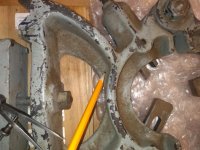marka12161
Stainless
- Joined
- Dec 23, 2016
- Location
- Oswego, NY USA
So i bought a steady rest that was close to the right dimensions for my mid 30s RP gear head lathe. Basically the "V" slot on the steady rest needs to move toward the center of the steady by about 1".
My plan is as follows:
Cut out a one inch section of the base approximately at the location indicated between the small dividers.
Cut the brace on the "V" side at the interface between the brace and the lower half circle as indicated by the pencil points.
Establish horizontal alignment of the base pieces and braze the base together on the bottom and braze the brace to the lower half circle.
This plan would provide the necessary side clearance between the base and the saddle and would register the center of the circle on the center-line of the spindle.
I'm feeling like the hardest part is going to be to establish alignment of the base and that the worst thing that i would have to deal with is to mill the bottom flat and shim it up.
Please let me know what you think.
Mark
My plan is as follows:
Cut out a one inch section of the base approximately at the location indicated between the small dividers.
Cut the brace on the "V" side at the interface between the brace and the lower half circle as indicated by the pencil points.
Establish horizontal alignment of the base pieces and braze the base together on the bottom and braze the brace to the lower half circle.
This plan would provide the necessary side clearance between the base and the saddle and would register the center of the circle on the center-line of the spindle.
I'm feeling like the hardest part is going to be to establish alignment of the base and that the worst thing that i would have to deal with is to mill the bottom flat and shim it up.
Please let me know what you think.
Mark







